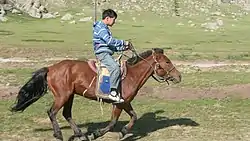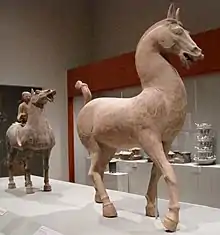< Reconstruction:Proto-Sino-Tibetan


Reconstruction:Proto-Sino-Tibetan/k-m-raŋ ~ s-raŋ
Proto-Sino-Tibetan
Etymology
- Proto-Sino-Tibetan: ?
- Proto-Tibeto-Burman: *k-m-raŋ ⪤ s-raŋ (Matisoff, STEDT); *m-raŋ ⪤ s-raŋ (Weidert, 1987; Benedict, 1972).
Similar roots also exist in other families in the region, cf.
- Languages of Southeast Asia
According to Benedict (1972), Proto-Mon-Khmer and Proto-Tibeto-Burman forms *m-raŋ and Old Chinese *mraʔ all descended from a plurisyllabic *m()raŋ() of unknown origin; further cf.
- Languages of Northeast Asia
Compare also Nahali māv ("horse"), Proto-Indo-European *márkos (“horse”) (whence English mare, marshal; Irish marc).
Written Tibetan རྟ (rta, “horse”) is from a different proto-Tibeto-Burman source *rta (“horse”) and is hence unrelated.

Mongolian horse, the horse breed perhaps close(st) to the Chinese ancient horses (Cai et al., 2009.

Ceramic statues of a prancing horse (foreground) and a cavalryman on horseback (background), Eastern Han Dynasty (25-220 AD) of China.
Descendants
- Old Chinese: 馬 /*mˤraʔ/ (B-S), /*mraːʔ/ (ZS) ("horse")
- (in the oracle bone script)

- (in the oracle bone script)
- Kamarupan
- North Assam
- Deng
- Taraon: mɑ³¹ ɹoŋ⁵⁵
- Deng
- Kuki-Chin: *raŋ ("horse")
- Central Chin
- Lai: ràŋ
- Maraic
- Lakher [Mara]: /ā rā/
- Central Chin
- "Naga"
- Northern Naga
- Wancho: /man/
- Northern Naga
- North Assam
- Himalayish
- Tibeto-Kanauri
- Bodic
- Tibetan
- Written Tibetan: རྨང (rmang, “(archaic, rare) horse”)
- Tibetan
- Western Himalayish
- Zhang-Zhung: /hraŋ/
- Kanauri: /raɴ/
- Pattani [Manchati]: /hraŋ/
- Bodic
- Mahakiranti
- Kham-Magar-Chepang-Sunwar
- Chepang: sĕraŋ
- Kham-Magar-Chepang-Sunwar
- Tibeto-Kanauri
- Tangut-Qiang
- Qiangic
- Southern Pumi: zgyɛ̃¹³
- Qiang (Longxi): /ʁò/
- Qiang (Mawo): /ɹu/
- Qiang (Mianchi): /ʐòu/
- Queyu (Xinlong): /bre¹³/
- Shixing: /rõ³⁵/
- Zhaba (Daofu County): /mbʐo¹³/
- rGyalrongic
- Horpa: [script needed] (/ʐɣi/)
- Japhug: mbro
- Situ: mbro /mbroʔ/
- Tshobdun: ⁿbri
- Qiangic
- Jingpho-Nung-Asakian
- Jingpho
- Jingpho: kum³¹ ʒa³¹
- Nungic
- Nung: /mɛn³¹/
- Drung: mɯ³¹ gɯ⁵³
- Asakian
- Sak: /məráŋ/
- Jingpho
- Tujia
- Tujia: /ma⁵³/
- Lolo-Burmese-Naxi
- Lolo-Burmese:
- /*mraŋ²/ ("horse") (Matisoff, 2003)
- Burmish
- Loloish:
- /*mraŋ²/ ("horse") (Bradley, 1979)
- Northern Loloish
- Nusu (Central): /mɹə⁵⁵/
- Yi (Liangshan): ꃅ (mu, “horse”) /mu³³/
- Central Loloish
- Yi (Sani): /m̩⁵⁵/
- Southern Loloish
- Hani (Lüchun): /mo³¹/
- Naxi
- Na (Yongning): /ʐwæ⁵/
- Lolo-Burmese:
- Baic
- Bai: maix (“horse”)
This article is issued from Wiktionary. The text is licensed under Creative Commons - Attribution - Sharealike. Additional terms may apply for the media files.
